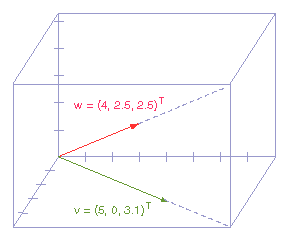- Compute the lengths:
- | w | = (keep it symbolic)
- | v |2 =
((5, 0, 3.1)T · (5, 0, 3.1)T)
= 34.61
- Compute the unit vectors:
- wu = (4, 2.5, 2.5)T / | w |
- vu = (5, 0, 3.1)T / | v |
- Compute the cosine of the angle between the vectors:
- wu · vu
= (4, 2.5, 2.5)T / | w | · (5, 0, 3.1)T / | v |
= 27.75/( | w || v |)
- Assemble the projection:
- kv = | w | (wu · vu) vu
- kv = | w | (27.75 / (| w || v |)) (5, 0, 3.1)T / | v |
- kv = (27.75 / (| v |)) ( (5, 0, 3.1)T / | v | )
- kv = (27.75 / | v |2) (5, 0, 3.1)T
- kv = (27.75 / 34.61) (5, 0, 3.1)T
- kv = ((27.75*5)/34.61, 0, (27.75*3.1)/34.61T
- kv = ( 4.00, 0, 2.49)T
|

|

